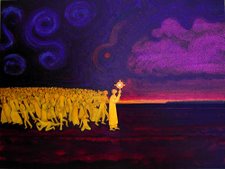
"I'm lost in admiration for Lamin Sanneh's magnificent study of world Christianity, for the work's geographical scope and historical sweep, and for the breadth of the author's learning. Throughout, Sanneh asks the critical question: how can we reconceive Christianity in a way that frees it from its European and imperial contexts, permitting the faith to adapt to the kaleidoscopic realities of different societies around the globe. This is a splendid achievement." --Philip Jenkins, author of The Next Christendom and The New Faces of Christianity
By Matt K. "happy reader" (Michigan, USA)
A spate of recent works on "world (or global) Christianity," including Philip Jenkins' widely read "The Next Christendom" (New York: Oxford Univ. Press, 2007), have drawn needed attention to one of the most striking developments of the past century: the rise of a "Post-Western Christianity" which is now firmly rooted and growing dramatically in parts of Africa, Asia, and Latin America.
In his recent book, "Disciples of All Nations: Pillars of World Christianity," Lamin Sanneh sets out to describe some of the "pillars" or roots of this worldwide Christian awakening, which he calls the "Third Awakening" (p. 274). It is a wide-ranging study that chronicles the fascinating, if somewhat messy, story of Christianity's naturalization (or "inculturation") and growth among various peoples throughout its history. It is the story of Christianity becoming "the most diverse and pluralist religion in the world." To tell the story, Sanneh focuses on certain themes ("pillars") that define "world Christianity," and then illustrates them in multiple ways, drawing out interesting implications along the way.
It is an eye-opening study that contains fascinating, and sometimes myth-busting insights about our understanding of the nature of the Christian religion, our understanding of Western missions, and the role of local agency and native resources in the spread of Christianity. Anyone interested in the worldwide Christian movement or current events would greatly benefit from Professor Sanneh's thorough study.
Let me offer one small warning: someone reading "Disciples of All Nations" without a decent background in the history of Christian missions may well find this book overwhelming. Sanneh has such a remarkable breadth of knowledge and draws his examples from such a variety of contexts that I sometimes struggled to stay with him. At times, Sanneh rather abruptly turns to particular historical examples that feel more like extended rabbit trails than helpful contributions to the flow of his argument. The book would have been much strengthened by clearer organization. Still, in spite of this, I warmly recommend the book.
One of Sanneh's dominant themes that emerges again and again is that Christianity has a "peculiar temper"(p. 12) acquired through its long encounter with a dizzying diversity of cultural, political and social contexts. "The characteristic pattern of Christianity's engagement with the languages and cultures of the world has God at the center of the universe of cultures, implying equality among cultures and the...relative status of cultures vis a vis the truth of God. No culture is so advanced or so superior that it can claim exclusive access or advantage to the truth of God, and none so marginal...that it can be excluded. All have merit, none is indispensable" (p. 25).
As such, Christianity both absorbs and transforms the cultures it encounters. It spreads by making local appropriations and adaptations with local cultural resources, while investing those preexisting materials with new meaning and purpose. All that is to say, one reason for Christianity's appeal as a world religion is that it is a "translated and translating" religion, a religion with an "amazing power of adaptation" which enables it to speak to the heart of human beings in exceedingly diverse historical and cultural situations.
If this "peculiar temper" of Christianity is one of the faith's greatest strengths, it has too often been hindered by notions of cultural superiority, and connections to political power. Sanneh shows, again through a multitude of examples, the "heavy price" that has often been paid when Christianity's "intrinsic character as a worldwide religion... was framed in the uniform tenets of Christendom," and thus used to justify exploitation and domination (p. 54).
In the West, this is an often-told story: the story of missionary complicity in colonial imperialism. Sanneh is not shy to point out many examples of this. But, he is quick to add, though western scholarship and popular opinion would have us believe otherwise, that is not the whole story.
Sanneh writes, "I am urging a revisionist history without claiming that missions and colonialism were not in cahoots." So while acknowledging the colonial connections and mindset of many missions, Sanneh contends that "the frontier experience... ultimately transformed missions' agenda and modus operandi," so that many missionaries repudiated their ties to the colonial powers and worked for local empowerment in the cause of Christ. There were many shining examples of this throughout missions history. Missions saw increasingly that though the Gospel was a universal message meant to flourish in any and every cultural milieu, the "crushing burden" of "Europeandom" had muted the Gospel and robbed it of its power.
Moreover, wether consciously or unconsciously, missionaries who translated the Bible into local vernacular languages, and who preached the essentials of Christianity, often sowed the seeds of local empowerment that contributed to the undermining of colonial domination.
Bible translation, it turned out, was a great act of cultural affirmation and empowerment. Bible translation work also produced grammars and lexicons for languages that otherwise might have disappeared.
Though Sanneh devotes a great deal of attention to foreign missions, that is not his ultimate focus; to focus on Western missions would be to misread Sanneh. Throughout "Disciples of All Nations," he explicitly shifts the focus from expatriate initiative to local reception, from foreign control to native direction. This is another crucial and convincing aspect of Sanneh's argument.
Sanneh claims that scholarship related to the growth of Christianity in Africa and the colonial era often makes the same mistake the colonial powers made: they ignore the vital, creative, energetic response and involvement of local people themselves.
However, Sanneh contends that this one-sided picture of native passivity in the face of missionary hegemony is far wide of the mark. It soon became clear that while foreigners may have been the initial bearers of Christian teaching to parts of Africa, Africans had taken the ball for themselves and run with it.
In the last chapter of the book, Sanneh points out a similar Chinese appropriation of Christianity which took place in very different circumstances. In its paranoid repression of Christianity as a "foreign religion," the communist revolution in China (itself the bearer of a foreign ideology - Marxism) ironically cleared the decks for the thoroughly Chinese Christian awakening that is currently underway in China (ch. 8).
Returning to Africa, it became clear that Africans wanted Jesus, they wanted the Bible, they wanted healing and miracles and power over evil in the spirit realm (things they found ample evidence for in the Bible), but not the European civilization that was supposed to accompany Christianity (something the Bible seemed to oppose at many points). Sanneh provides a cogent summary: "It is remarkable the extent to which colonial co-option weakened Christianity by presenting it as a freshly minted European creed. Africans rejected that view by circulating the religion as local currency" (p. 161).
On the one hand, then, African Christians brilliantly separated the Christian kernel from the colonial husk, and made Christianity their own. In so doing, they often recaptured the spirit of primal apostolic Christianity against its secularized European counterpart. On the other hand, this story illustrates that Christianity itself, with its "peculiar temper" refused to be domesticated. It is almost as if Christianity itself was just waiting to shake off its colonial baggage and break out in fresh ways in these new contexts.
In the end, by putting the Christian movement into the broader context which I have attempted to summarize above, Lamin Sanneh has convincingly shown that the present growth of world Christianity, while unprecedented in its scale, is not at all out of character. By carefully demonstrating the "peculiar temper" of Christianity, the two-sided process of Christian expansion (missionary outreach and local appropriation), and the "serial nature" of Christian history, Sanneh has helped us to see again that Christianity is a dynamic world religion, a religion able to flourish and be "at home" in a wide variety of cultural, linguistic, social and political contexts.
This may be surprising in certain quarters, for example, where the Western pedigree of Christianity has been long assumed, or where the supernaturalism of Christianity has been long assumed discredited. But this surprise may well say more about the cultural or ideological captivity of these quarters than it does about the true nature of the faith.



No comments:
Post a Comment